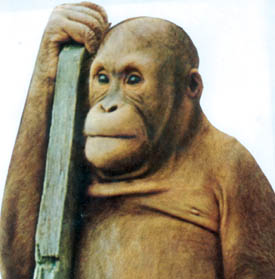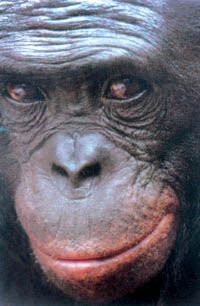|
DAILY NEWS ONLINE |
|
|
|
OTHER EDITIONS |
|
|
|
|
|
|
|
|
|
OTHER LINKS |
|
|
|
|
|
|
 |
Where have all the big apes gone?
MOST thinking people now fully accept the basic theory of evolution. Few have problems with the idea that humans have descended from the apes, and that apes themselves evolved from more primitive mammals. Bonobos, chimpanzees, gorillas and orangutans, our closest relatives in the evolutionary stream, are fast disappearing in contrast to humans who are multiplying by leaps and bounds to over six billion still counting. Bonobos are a rare form of chimpanzee, believed to be our closest relative among the apes. This species was discovered in the Democratic Republic of Congo (DCR) in 1929. Logging and poaching Bonobos are also known as gracile chimpanzees, because they are slender and much more delicately built with long legs and small head atop narrow shoulders. They are more intelligent than gorillas and common chimps. The main threat to chimps and gorillas in Africa is habitat destruction by way of logging and poaching. Poaching goes hand in hand with logging and the clearance of forests, providing access to hitherto inaccessible areas, and a source of food for imported migrant workers. In Cameroon, Gabon and DRC, multinational loggers have dominion of over 60 per cent of the land. One logging camp, for example, in the Congo harvested 8,250 animals in a single year. People have traditionally killed and eaten almost all forms of wild animals in Africa. But within the last 20 years or so there has been a huge rise in bushmeat hunting. It has now become a big business. This has had adverse effects on endangered species like chimpanzees, gorillas, monkeys and duikers (antelopes). During the mid-1990s the number of bonobos was thought to be between 100,000 and 30,000. Today's estimates are between 50,000 and 10,000. There were about two million chimps (other than bonoboes) in 1900 ranging over 25 countries in tropical Africa from Tanzania to Senegal. Since then they have become extinct in Benin, Gambia and Togo, and virtually extinct in Burkina Faso, Ghana, Guinea Bissau and Senegal. Their numbers have now dropped to about 200,000. Gorillas have suffered the same fate. Grauer's gorillas, found on the eastern side of Africa have been most affected. Their numbers have plummeted from 17,000 in the mid-1990s to a mere 3,000 in 2004. On the western side, gorillas are found stretching northwards from Angola to Nigeria and inwards into the DCR. In Gabon, a stronghold of this species, numbers have dropped by 50 per cent in the last 20 years. Only the mountain gorilla species found in eastern DCR, Rwanda and Uganda - the one that Dian Fossey made famous - has the distinction of having its numbers increased from 620 in 1989 to 700 in 2004. Disease
Apart from habitat destruction and poaching, disease has also to be taken into consideration in respect of declining numbers in gorilla and chimpanzee populations. The most alarming disease is ebola - a haemorrhagic virus which has a very high rate of mortality. The past ten years has seen outbreaks in Gabon and Congo, and a large number of chimps and gorillas have been lost since 2001 in the areas between the two countries. IndonesiaUnlike its African cousins, the orangutan (old man of the forest) is Indonesian, found in the tropical forests of Borneo and Sumatra. A thorough survey conducted in 2003 has shown that since 1900 the numbers of Bornean and Sumatran species have dropped by 76 and 93 per cent respectively. The greatest problem to the survival of orangutan populations is habitat destruction - principal cause being the spread of palm-oil plantations and uncontrolled forest fires. Unlike chimps and gorillas who can survive in disturbed forests, orangutans cannot because they are dependent on the trees themselves, where they spend most of their lives in the canopy to find their food and build their nests. Authoritative sources are of the opinion that Sumatran orangutans are on the verge of extinction about a decade away, and that the bonobos will be next. UNGoing... going... soon to be gone! Can we let this happen to these wonderful creatures, who are our closest relations among the primates? The United Nations thinks not, and is at present involved in generating international support for a more concerted effort at their protection. The most important step in this direction will come in September 2005, when the UN will launch the 'Great Ape Survival' project (GRASP) in Kinshasa, DRC. The objective is to have all the range states lined up with greater representation and cooperation in particular with Central African logging businesses and the SE Asian oil palm companies, who are largely responsible for loss of habitat and poaching problems. One approach would be to develop partnerships with loggers and offer alternative forms of protein to the workers presently served with game food. The final aim is to develop a global strategy for great ape conservation that can be implemented according to the priorities of every range state. Even now GRASP's technical support team is helping the range states to develop and coordinate local conservation plans. |
||
|
|


